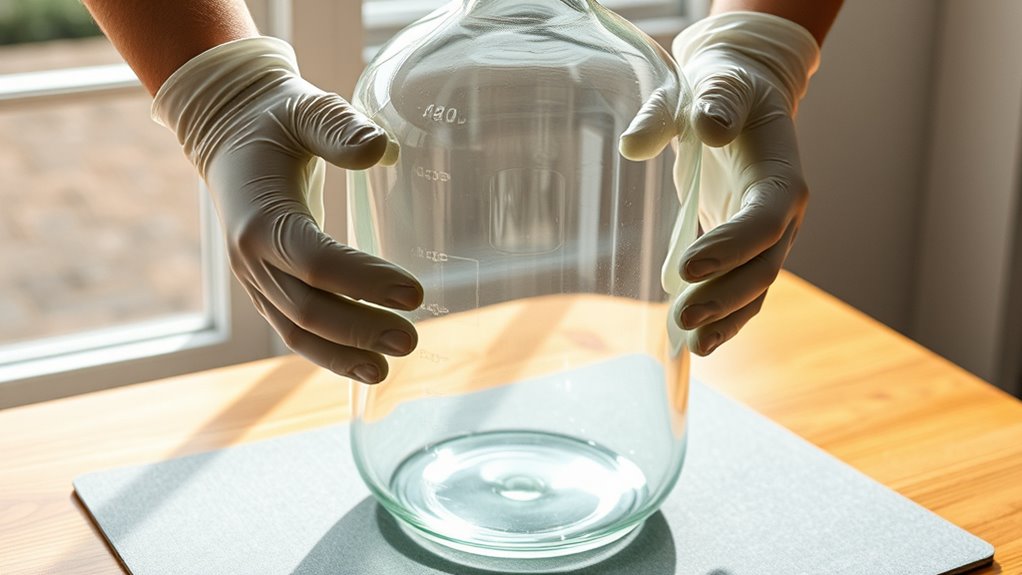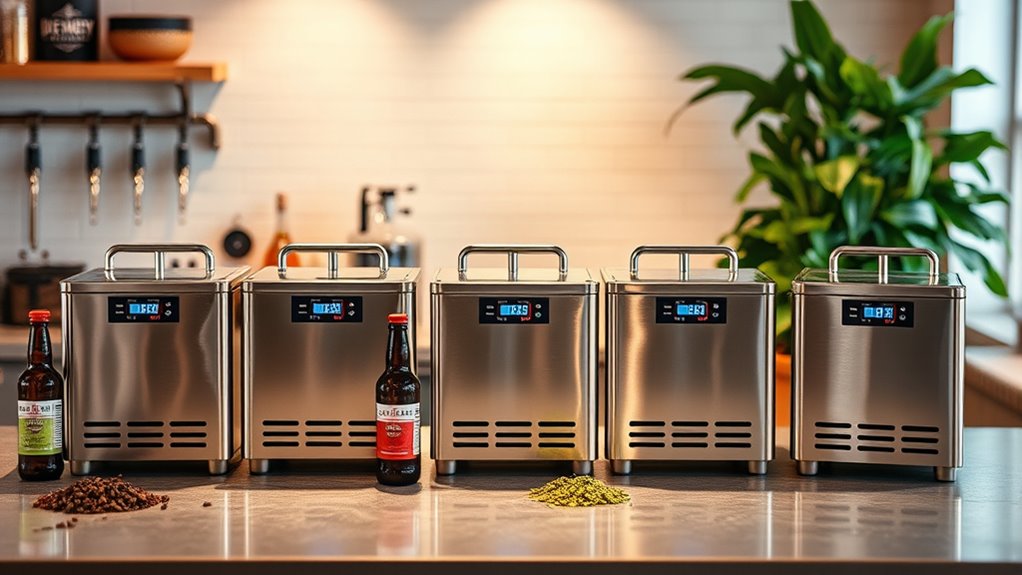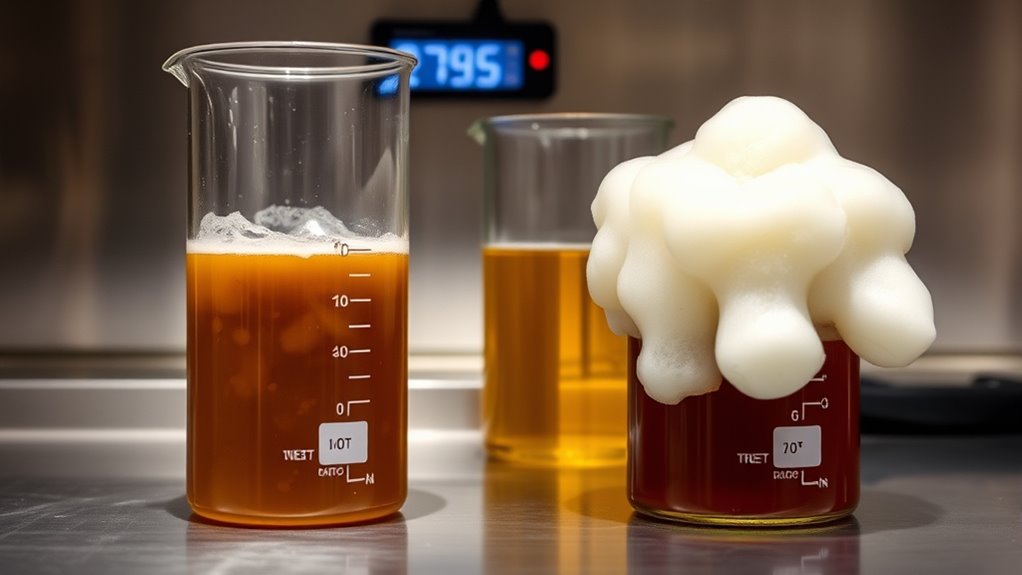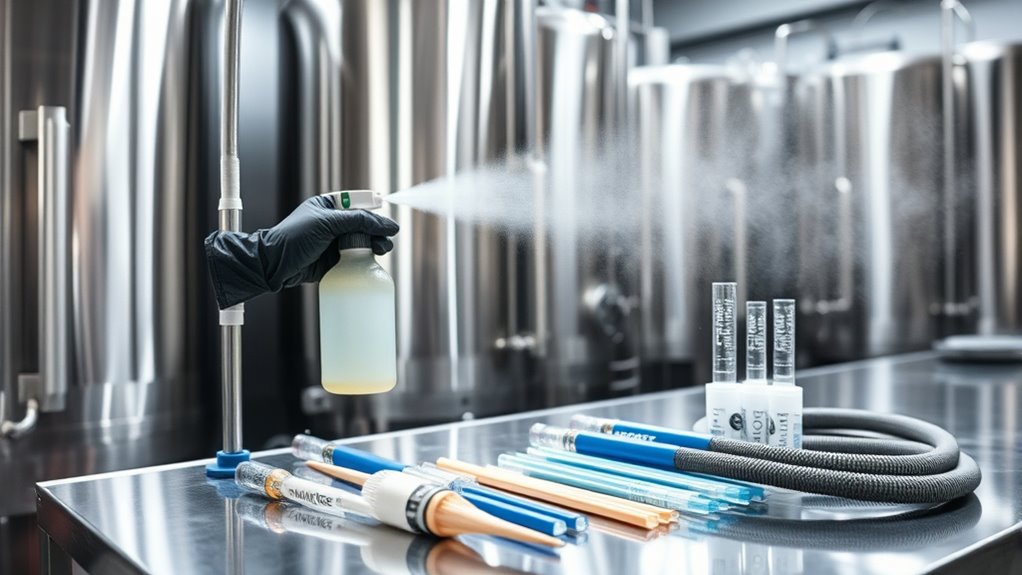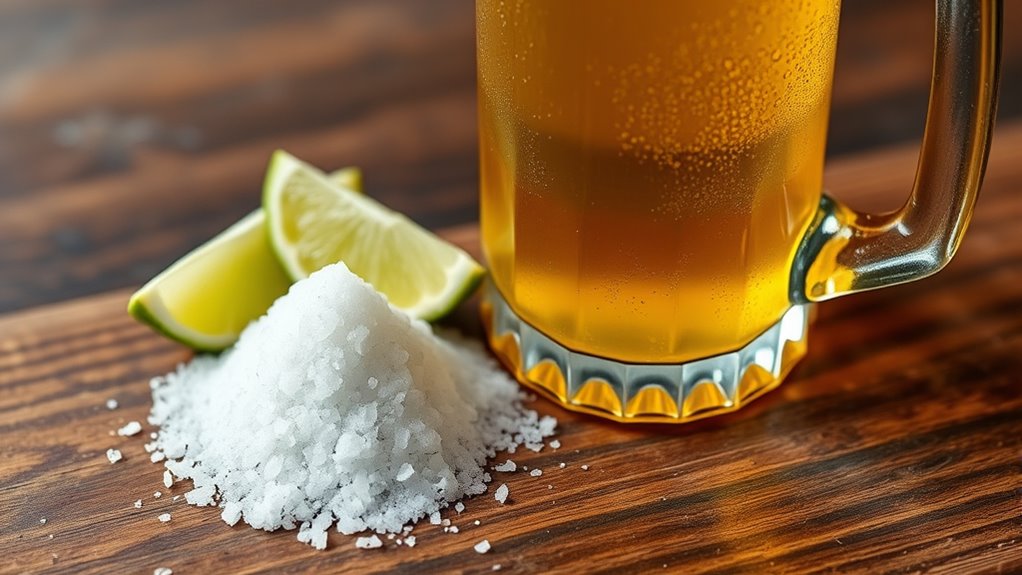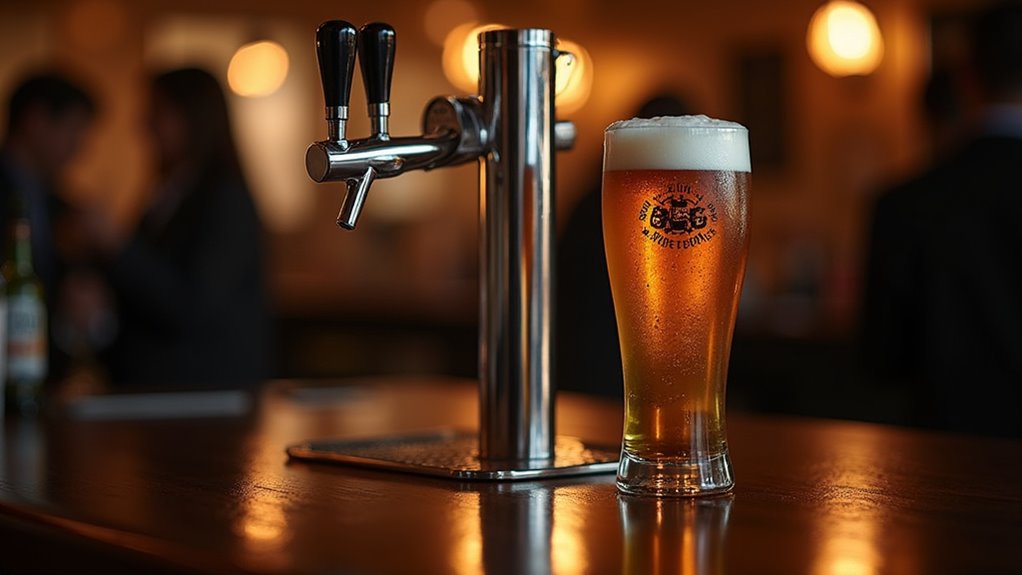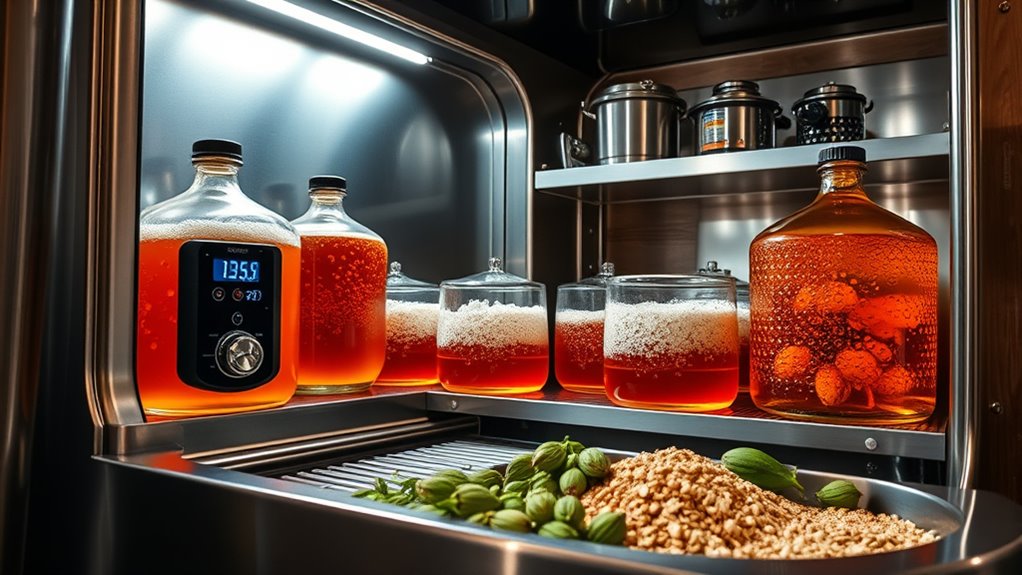To safely handle glass carboys, avoid thermal shock by acclimating them to room temperature. When lifting, use Brew Haulers for even weight distribution and milk crates for stability. Always support carboys from the bottom, keeping them close to your body. Assess your own ability to safely handle heavy and awkward carboys, and respect your personal limits to prevent accidents. The weight and awkward shape of full carboys can lead to back strains, sprains, or foot fractures if dropped, so always use proper lifting technique. Store them on sturdy surfaces, away from edges and high-traffic areas, and regularly check for cracks. Clean and sanitize using proper agents. By following these guidelines, you can guarantee both your safety and the carboy’s integrity. Discover more essential tips for carboy care.
- Always support carboys from the bottom, avoiding the neck or handles to reduce breakage risk during lifting and carrying.
- Use carrying straps or Brew Haulers for improved grip and even weight distribution when transporting carboys.
- Gradually acclimate glass carboys to room temperature to minimize the risk of thermal shock.
- Store carboys on stable surfaces, away from edges and high-traffic areas, to prevent falls and accidents.
- Regularly inspect for cracks or chips, and clean carboys thoroughly to maintain their integrity and safety.
Introduction to Carboy Handling
Handling glass carboys is a crucial part of the brewing process, but it comes with its own set of risks. Glass carboys are inherently fragile, and a single slip or bump can cause them to break or shatter, leading to a big mess and potentially serious injuries. Whether you’re lifting a full glass carboy, washing out residue, or simply moving it across the room, it’s important to treat the glass with respect. Avoid putting pressure on the neck, as this is a common weak point that can easily crack or snap if mishandled. Sudden temperature changes—like pouring hot water into a cold carboy—can also cause the glass to fracture due to thermal shock. Always be careful when handling, lifting, or cleaning your carboy, and remember that a little extra caution can make a big difference in preventing accidents and keeping your brewing experience safe and enjoyable.
Understanding Thermal Shock and Its Risks
When you handle glass carboys, it’s important to be aware of thermal shock and its potential dangers.
Glass carboys, especially 5-gallon sizes weighing over 40 lbs when full, can shatter catastrophically due to thermal shock or structural failure.
Thermal shock happens when rapid temperature changes cause the glass to expand or contract unevenly, leading to stress and possible breakage. For instance, placing a hot carboy on a cold surface, like granite, heightens the risk of failure.
Glass carboys can also randomly explode, leading to injuries and significant messes.
Thermal shock occurs when glass experiences rapid temperature changes, risking stress and breakage. Avoid placing hot carboys on cold surfaces.
To prevent this, always set hot carboys on stable surfaces that don’t cool quickly and use a towel for cushioning. By avoiding drastic temperature changes and ensuring proper placement, you can minimize the risk of thermal shock and maintain safety while brewing.
Helpful Hints:
- Use insulated surfaces for hot carboys.
- Gradually acclimate glass to room temperature.
- Always handle with care.
- Never seal a carboy containing hot liquid and shake it, as this can cause explosive pressure build-up.
- Avoid adding hot water to a cold glass carboy; use warm water for cleaning and acclimate the carboy gradually.
- Always place a towel, cardboard, or a piece of carpet under the carboy to cushion the bottom and prevent cracking on hard surfaces.
Best Practices for Lifting and Carrying Carboys
Lifting and carrying glass carboys requires careful attention to technique to secure safety and prevent accidents. Lifting a full glass carboy can be dangerous and may lead to accidents if it slips or breaks.
To guarantee effective lifting, follow these best practices:
- Always use carrying straps or Brew Haulers to distribute weight evenly.
- Utilize milk crates for stability, avoiding direct lifting of full weight.
- Support the carboy from the bottom, not the neck or handles.
- Maintain a stable grip, keeping the carboy close to your body.
- Avoid carrying by the neck, as it concentrates weight and increases breakage risk.
- Use a carboy sling that wraps around the bottom and sides for safe lifting.
- Lift with proper ergonomics: bend at your knees and keep your back straight to avoid injury.
- Minimize movement by sliding the carboy along the floor instead of carrying it across the room.
Carboy-related injuries are most commonly associated with glass breakage and physical strain from heavy lifting, so safely handling a glass carboy is critical to avoid severe lacerations or physical injury.
Recommended Tools for Safe Transport
Ensuring safe transport of glass carboys is essential to prevent accidents and breakage, especially during fermentation and racking. To enhance safety, consider using Brew Haulers, which distribute weight evenly and offer dual handles for better grip.
Wet carboys are extremely slippery, especially when filled with liquid, so use caution and wear protective gloves and shoes when handling them.
For added stability, milk crates can support 5-gallon and 6.5-gallon carboys, allowing you to move them without lifting the entire weight—ideal for siphoning tasks. Additionally, employing strap systems can improve grip on slippery surfaces.
Always check the stitching on Brew Haulers for integrity before use, and cushion carboys with padded towels or cardboard to prevent impacts during transport.
Helpful Hints:
- Use Brew Haulers for better grip.
- Milk crates stabilize carboys.
- Check stitching for safety.
- Cushion with towels or cardboard.
- When cleaning with oxygenating cleansers, use plastic wrap or a loose cover instead of a tight stopper to prevent pressure buildup.
Safety Equipment and Gear
To reduce the risk of injuries when working with glass carboys, having the right safety equipment and gear is essential. Using milk crates or half-size crates provides a stable base for carrying and storing your carboy, making it much less likely to slip or tip over during transport or washing. Carboy slings are another great tool, giving you a secure grip and better control when lifting or moving a heavy vessel. Don’t forget personal protective gear—wearing gloves and safety eyewear can help protect your hands and eyes if a carboy breaks unexpectedly. For added safety during washing, place a layer of plywood or a thick towel on your countertop to cushion the glass and reduce the risk of breakage. Keeping a first aid kit nearby and knowing basic emergency procedures can make all the difference if an accident does occur. By investing in the right equipment and taking these precautions, you can significantly lower the risk of injuries and create a safer brewing environment.
Proper Storage Techniques to Prevent Accidents
Proper storage techniques are essential to preventing accidents with glass carboys. To guarantee safety, follow these guidelines:
Many homebrewers store their carboys in the basement or garage, where they can sit safely out of the way. If you have a bunch of carboys, keeping them together in a dedicated storage area can help prevent accidents.
Proper storage techniques are crucial for preventing glass carboy accidents and ensuring safety.
- Store carboys on low, sturdy shelves away from edges and high-traffic areas to avoid bumps.
- Store carboys on sturdy, stable surfaces, avoiding high-traffic areas.
- Use milk crates for added stability when moving or storing.
- Place carboys on soft padding to prevent the bottom from cracking if set down too hard.
- Place carboys on soft padding, like towels or cardboard, instead of hard surfaces, reducing impact risk.
- Keep carboys away from edges of shelves or countertops to prevent falls.
- Covering a glass carboy with an old sweatshirt can block light and provide minor impact protection.
- Regularly inspect for cracks or chips to maintain integrity.
Safety Inspections: Ensuring Carboy Integrity
Before you start using a glass carboy, it’s essential to conduct a thorough safety inspection to guarantee its integrity.
Always inspect the carboy’s material thoroughly with a bright light for any cracks, chips, or scratches before each use. Even small hairline cracks in glass carboys can render them unsafe for use and should be taken seriously.
First, use a bright light to check for visible cracks or defects, as even minor imperfections can lead to failure during use.
Examine the inside for any residue or lingering odors, which may indicate previous contamination
Verify the carboy is whole, free from chips or scratches, and look for signs of past stress, like discoloration.
Finally, confirm the carboy meets the required volume for your brewing needs.
Conducting these safety inspections will help ensure a successful brewing experience.
Cleaning and Sanitizing Your Carboy Safely
Cleaning and sanitizing your glass carboy is an essential step in the brewing process, as it helps prevent contamination and guarantees the quality of your final product.
- Inspect for cracks and defects using bright light.
- Always wear protective equipment such as closed-toe shoes, cut-resistant gloves, and safety glasses when cleaning or moving carboys.
- Clean with appropriate glass cleaning agents, rinsing thoroughly. When you fill the carboy for cleaning, do so carefully to avoid spills or splashes, and note that a wide mouth makes both cleaning and filling much easier.
- Use a bottle brush for hard-to-reach areas to avoid residue buildup. If breakage or improper cleaning occurs, you may end up with a mess and stuff like glass shards or leftover residue, so thorough cleaning is important.
- Sanitize with a suitable solution to eliminate harmful microorganisms. Proper sanitization is critical to prevent contamination that can spoil beer flavor and consistency. Many homebrewers have reported injuries from glass carboy accidents, including stitches and severe lacerations.
- Allow the carboy to dry completely before storing or using it. Flying glass shards from an exploding carboy can cause permanent eye damage or loss of sight, so always use caution.
When preparing your carboy to ferment beer, ensure it is completely clean and sanitized before you fill it with wort. After filling, you’ll need to wait patiently for fermentation to finish before your beer can be tasted.
When it comes to safely handling glass carboys, many homebrewers find that sharing insights and experiences can greatly enhance safety practices.
For instance, using milk crates for transporting carboys can stabilize your load while notably reducing the stress of lifting heavy vessels. Many brewers recommend Brew Haulers, as they distribute weight evenly, providing a secure grip.
Additionally, it’s wise to test new carrying methods, like straps or bags, with water-filled carboys first. Community discussions often emphasize the severity of injuries from shattered glass, reinforcing the importance of using reliable equipment to avoid accidents.
Stay innovative and prioritize safety.
Emergency Procedures
If a glass carboy breaks, quick and calm action is key to minimizing injuries and further risk. First, assess the situation—if anyone is hurt, especially with cuts to the neck or arms, immediately apply firm pressure to the wound to slow bleeding and seek medical attention right away. Always have a first aid kit within reach and know the fastest route to the nearest emergency room. If the breakage happens during brewing, contain the spill as best as you can to prevent slips or additional accidents. Avoid touching broken glass with bare hands; use gloves or a thick towel to clean up the area safely. Having a phone nearby for emergency calls and being familiar with basic first aid procedures can make a big difference in a stressful moment. By preparing for the unexpected, you can help ensure that a broken carboy doesn’t turn into a bigger problem.
Alternatives to Glass
If you’re concerned about the risks that come with glass carboys, there are several safer alternatives to consider. Plastic carboys, like Fermonsters or Better Bottle models, are popular among homebrewers for their durability and ease of cleaning. Many brewers have noticed a big difference in peace of mind when switching from glass to plastic, as the risk of shattering is virtually eliminated. Stainless steel fermenters are another excellent option, offering a sanitary and long-lasting container for your beer or wine. Buckets and kegs made from food-grade plastic are also widely used, providing a cost-effective and sturdy alternative to traditional glass carboys. By exploring these options, you can reduce the risk of injury and create a safer brewing setup—without sacrificing the quality of your final product.
Common Mistakes to Avoid
When working with glass carboys, avoiding common mistakes can help prevent accidents and injuries. One of the biggest risks is dropping a carboy, which can happen in a split second and result in a dangerous mess. Always use milk crates or carboy slings to lift and carry your vessel, and never try to move a full carboy by the neck—this area is especially vulnerable to breakage under pressure. Another frequent error is exposing glass carboys to sudden temperature changes, such as adding hot water to a cold container, which can cause the glass to crack or shatter due to thermal shock. Be careful not to put unnecessary pressure on any part of the carboy, and remember that even an empty carboy can break if mishandled. It’s also wise to sanitize your carboy with starsan before use to prevent contamination. Accidents can happen at any moment—even years ago, many brewers have learned this lesson the hard way—so always handle your glass carboys with care and attention to detail.
